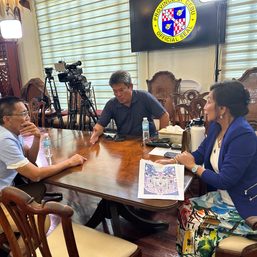SUMMARY
This is AI generated summarization, which may have errors. For context, always refer to the full article.

BAGUIO, Philippines – Since May, the Benguet Museum has opened its doors to children from first to third grades, offering them interactive conversations about items of importance in Ibaloi culture.
Guided by museum staff, the children use activity sheets that feature one item at a time, such as a basket, along with descriptions of its use.
The small group discussions help young learners recognize each artifact and associate it with daily life. The sessions include further questions to stimulate conversations, ensuring the children are actively engaged and not left to figure out the information on their own.
One example is the ubiquitous kayabang, a basket with a square base made of woven rattan and wood, used to carry crops.
A woman attaches an epid (burden strap) made of woven rattan to the kayabang. The broad side of the strap rests on her head, leaving her hands free to navigate the mountain slopes while harvesting kamote (sweet potatoes). She can easily toss each kamote into the upright kayabang resting against her back.
The kayabang is also used to carry harvested rice stalks and vegetables, according to Kenneth Kelcho, Benguet tourism officer.
“I grew up pounding rice, but for many of the children here, that is not a familiar sight,” he said.
For Kelcho, cultural values can be drawn from items of material culture.
“There is always a story in every artifact. We hope that the learners will appreciate these items of our culture, whether or not they see them still being used.”
Kelcho, an Ibaloi originally from Kabayan town, has long been a staunch advocate of cultural awareness and appreciation, especially among the younger generation.
Incidentally, his town is known for the ancient Fire Mummies, which remain in their original cave resting places, and for being home to a large part of Mount Pulag, the highest peak in Luzon.
Benguet Governor Melchor Daguines Diclas, who has been supporting the initiative, said the innovation is a major step toward reviving public interest by transforming the way artifacts are presented and making the museum experience more interactive.
Through this, the museum hopes to foster an appreciation of the local history and culture of the Ibaloi in the province among children.
“We want them to learn about their culture in a relaxed and informal environment. They already come from a structured (and tiring) classroom setting. By doing this, we can help them associate learning about their culture as a fun and interesting activity,” Kelcho said.
Love for arts
The museum’s gallery is a mid-sized room on the second floor of a building within the Benguet Capitol Complex in La Trinidad town. Despite its size, the collection of donated items is extensive, including a scale model of a traditional house, various tools used for fishing and farming, textiles, and musical instruments. These items can be viewed for free from 8 am to 5 pm daily, except on holidays.
The museum noted that many children pass by on their way home from school.
“The museum is a public place, so we have to make it accessible and interesting to everyone, including the young learners. We never know, they could come back later as advocates, teachers, experts, anthropologists. Their exposure to the items and activities in the museum could be a start,” Kelcho said.
Soon, works of artists from all over the province, however young, will also be displayed at the museum.
“We want to help motivate young artists in Benguet. If they see that their works are appreciated, then they can imagine art as a viable option for their future,” Kelcho said.
Kelcho and his team plan to facilitate similar activities for students up to 6th grade starting this year. They are preparing more audio-visual presentations to further enliven these learning sessions with children. – Rappler.com
The Benguet Museum can be reached through (074)-4222004, 0929-4846740 or benguet.governor@gmail.com.
Add a comment
How does this make you feel?















There are no comments yet. Add your comment to start the conversation.